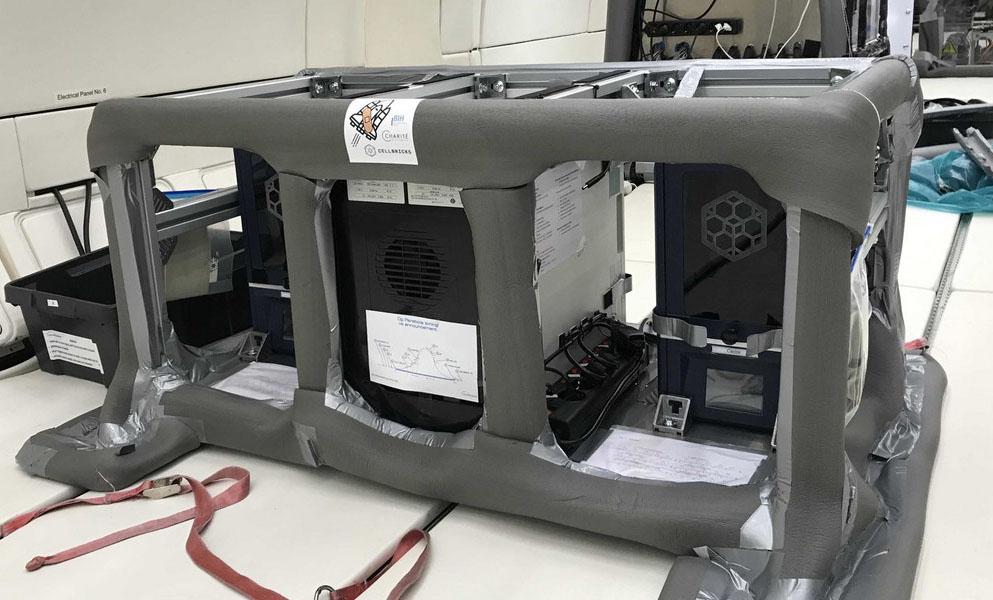| Feb 17, 2022 |
Biological bandages from a 3D printer, for use in outer space
|
|
(Nanowerk News) When it comes to burns or abrasions that measure several square centimeters in total area, the body’s self-healing powers are overwhelmed and often only an autologous skin graft can help. But problems arise both during the removal and transplantation of skin, explains Professor Georg Duda, director of the Julius Wolff Institute of Biomechanics and Musculoskeletal Regeneration at the BIH and spokesperson for the BIH Center for Regenerative Therapies (BCRT). “Unfortunately, skin grafts often lead to scarring, which is not a satisfactory outcome, both medically and cosmetically, for either the physician or the patient.”
|
|
In their search for an alternative, Duda’s team of scientists came across Cellbricks, a company that has developed a 3D printer capable of producing custom skin patches of various sizes and shapes.
|
 |
| A 3D printer that can produce a biological wound closure in a box that an withstand the stresses of parabolic flight. (Image: Bianca Lemke / BIH)
|
Biological printing ink
|
|
“In our case the printing ink is biological,” explains Bianca Lemke, a PhD student working with Professor Duda. “It consists of a special form of gelatin with methacrylate ends that hardens when exposed to UV light. We mix that with skin cells that ideally come from the graft recipient. And if we go to great technical lengths, we can even print tiny tubes into the mixture, which we then populate with blood vessel cells to ensure that the skin patch contains blood vessels.”
|
|
The shape and size of the required wound closure can be adjusted on the printer, and printing can take one or several hours depending on how challenging the particular bandage is.
|
|
“At a symposium hosted by the German Aerospace Center (DLR), the question arose as to whether 3D bioprinting could not also be used for astronauts,” the engineering graduate recounts. “After all, it is a long way to Mars, and even from the ISS you cannot return to Earth quickly if you have sustained a major injury. And that’s where a custom solution such as this would be quite practical.”
|
|
But now the question arises as to whether such a 3D printer would even work in weightlessness or zero gravity. Won’t the liquid ink float away? Will the gelatin harden as planned?
|
Parabolic flight experiment
|
|
In order to answer these questions, Lemke is taking off from Paderborn today on a parabolic flight on which the 3D printer will be tested. “Various safety checks will be conducted before takeoff. Since we are printing with liquids and these could spread throughout the aircraft during the microgravity phases, we must of course take measures to prevent this. The printers are situated in a box that has to withstand various mechanical tests and stresses, so this will also be checked. After that is done everything will be covered with padding, so that none of the participants accidentally bump their heads while floating around the plane’s cabin. And then the whole thing goes into the plane where it will be mounted. Various functional tests are conducted on board the aircraft to make sure everything works here too. And then we take off!”
|
|
During the five-hour flight, 31 parabolas are flown, which means the plane flies upward on a parabolic arc and then descends steeply before flying upward again. During the upper part of the parabola, weightlessness is experienced for about 20 seconds; during the ascent and descent, multiple gravitational forces are produced for a short time.
|
|
To check how the the Earth’s gravitational force affects the printing result, Lemke will integrate microbeads into the printing ink: “These microbeads are small fluorescent spheres about the size of cells. We are using them to study the sedimentation behavior of cells during the flight. This is because we have already observed on Earth that cells sink when the ink remains stationary for a longer period of time. We fear that all cells will sink during the hypergravity phases, but we hope that during weightlessness no cells at all will sink.”
|
|
Professor Duda will remain on the ground and is eager to learn the results: “We really hope the printing results are stable at least during weightlessness, because that would mean we could actually offer astronauts personalized wound care one day. Even though there is still a long way to go until then.”
|

